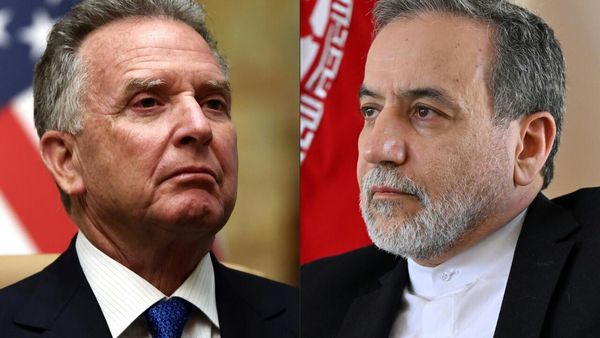(Bloomberg Businessweek) -- On the lower floors of Beijing’s Rainbow City mall, hundreds of people are shopping, dining with their families, and generally reveling in their Saturday night. Fifteen floors up, the headquarters of Chinese smartphone maker Xiaomi Corp. is all business. Beneath piercing fluorescent lights, employees with bright orange badges shuffle in and out of turnstiles, the weekend irrelevant. Hunched over a black wooden table in his modestly sized office, Chief Executive Officer Lei Jun preps for his 12th meeting of the day.
This March evening marks Lei’s first time in the office in a month. His regular trips to India on hold for the moment, he’s spent the last weeks traveling throughout China and Hong Kong, where bankers are prepping his eight-year-old startup for what’s expected to be the world’s biggest initial public offering this year. Xiaomi (pronounced she-yow-mee) filed IPO paperwork in Hong Kong in early May. The company didn’t disclose how much it plans to raise, but it could go public at a value of as much as $100 billion, which would make it the largest since Alibaba Group Holding Ltd. woke the world to China’s tech ambitions in 2014. Xiaomi booked 114.6 billion yuan ($18 billion) in sales last year, a 67 percent increase from 2016, and $1.9 billion in operating profits. That’s a long way from its dire standing just a few years ago, when the onetime Chinese smartphone leader was watching its market share tank.
Lei founded Xiaomi after running software maker Kingsoft Corp. and selling e-commerce startup Joyo.com to Amazon.com Inc. He says the money Xiaomi stands to make doesn’t interest him in and of itself; those in his orbit say it’s more what the money represents—the company joining the ranks of China’s so-called national champions, the likes of Jack Ma’s Alibaba, Pony Ma’s Tencent Holdings Ltd., and Robin Li’s Baidu Inc. “I wanted to lead a Chinese company,” the 48-year-old says, “to become No. 1 in the world.”
The finicky CEO has turned things around by micromanaging operations at a level Jeff Bezos might envy. Lei obsesses over pixel sizes on his phones’ screens and the rainbow colors of Xiaomi’s AA batteries. He hates seeing empty water bottles cluttering office desks, and his co-founders are used to him tweaking font sizes on their PowerPoint presentations. “Eight of us may be called co-founders, but the structure is really one plus seven,” says design chief Liu De. With Liu, Lei also contributed to the planning for Xiaomi’s new headquarters, down to choosing the urinals in the men’s bathrooms.
That campus, a 10-minute drive from the mall, will be Xiaomi’s home later this year. The glass-and-steel fortress is a testament to Lei’s ambitions and his battle to keep the comeback going. He has come close to building a Chinese internet giant that could put him on the same plane as Jack Ma, and he’s determined not to come up short, says Xiaomi investor Robin Chan. “Lei Jun felt he was just as smart, more experienced, and worked twice as hard,” Chan says. “Still, he was never considered one of them. At age 40, Lei Jun considered Xiaomi his best shot.”
Early on, Xiaomi distinguished itself by selling smartphones with the latest processors and features at half the price of competing devices. Relying on online flash sales and buzz from fans—no brick or mortar required—Lei’s company dominated China in a mere four years and became the world’s No. 3 phone maker after Apple Inc. and Samsung Electronics Co.
Xiaomi then pitched itself as a Google-style advertising and services company, rather than an Apple-esque hardware play, and was valued at $46 billion in 2014, when it raised $1.1 billion in venture capital. Seemingly out of nowhere, Xiaomi had become the world’s most valuable startup. (Uber later stole that crown.)
“That valuation number ended up being a curse,” Lei says, lamenting how the funding made Xiaomi a target. Local brands Oppo, Vivo, and Huawei flooded physical stores—where 85 percent of China’s smartphones were sold—with models about as cheap as Xiaomi’s. Online, Huawei Technologies Co.’s Honor brand copied Xiaomi’s sales model. Meanwhile, by 2016, Xiaomi was struggling to manufacture phones on schedule. Frustrated customers defected. Early that year, as China’s number of first-time phone buyers peaked, Xiaomi fell to fifth place in the local market and seventh globally, according to International Data Corp. “Our supply chain hadn’t been designed to handle that kind of growth,” says co-founder Li Wanqiang. “Small problems suddenly became big problems.”
In May 2016, Lei asked another co-founder to step aside as supply chain chief and took over the role himself. Lei, who with employees owns 60 percent of Xiaomi, personally negotiated with Foxconn, Samsung, and other suppliers to make sure Xiaomi wouldn’t have to wait on components, and stabilized production.
Throughout 2016, Li says, late nights turned into all-nighters punctuated with breaks for beer, barbecue skewers, and cigarettes. It’s tough to overstate how much analysts turned on the company, and Xiaomi ran its operations on loans rather than seek more venture capital, which might have risked cutting its value. “I prayed for Xiaomi,” says Richard Ji, who led Xiaomi’s 2014 funding round as the chief investment officer of All-Stars Investment. “I still had faith, but no one could have envisioned such a step down in growth. It caught us all off guard.” To fix its problems, Xiaomi had to “go big or go home,” Lei says. “We went big.”
Xiaomi began selling much more than phones. Through its venture capital arm, Xiaomi took stakes in hundreds of startups. Thousands of its engineers created music, video, and browser apps preloaded on its custom Android operating system, MIUI. There are Xiaomi-branded scooters, chargers, air purifiers, and suitcases, as well as video streaming apps and cloud storage. The company sells more than 500 products and services to 190 million monthly users in 70 countries.
Xiaomi built hundreds of physical stores to hawk all that new stuff, and its phones, mostly in China and India. The company scaled back operations elsewhere to focus on India, targeting the country’s first-time phone buyers by tailoring phones to their needs. Fifty miles from Bengaluru, for example, Lei and India chief Manu Jain visited a rural village to survey customers and retailers and learned that it could be difficult to predict which carrier offered a faster internet on a given day. They built their next phones with two SIM card slots so customers could switch from one provider to another.
Xiaomi also poured cash into the Mi MIX, the first phone it considered high-end enough to rival the latest from Apple, Samsung, and Huawei. In late 2016, Lei decided to set the price at 3,999 yuan ($636), one-third below what competitors suggested the company could charge. He made the decision early on the morning of the phone’s release, after rehearsing each of his PowerPoint slides 5 to 10 times. Although the Mi MIX wasn’t a huge seller, it convinced critics that Xiaomi had the technical chops to do battle with its bigger competitors.
Xiaomi executives compare their company’s approach to that of U.S. retailer Costco Wholesale Corp., which sells ketchup and Diet Coke at a discount, forgoing profits to acquire customers. Costco makes money by charging for membership and selling travel packages and other services. Seventy percent of Xiaomi’s sales are phones, on which it makes a profit of about $2 apiece, according to analyst Counterpoint Research. (Apple earns $250 per phone; Samsung, $19.) An additional 20 percent of Xiaomi’s business comes from such gadgets as air purifiers, scooters, and rice cookers, and in April, Xiaomi said it would forever cap profits from its phones and gadgets at 5 percent. But the preloaded apps and services that make up the last tenth of Xiaomi’s sales have net profit margins of 45 percent to 60 percent, people familiar with the business say. Based on those numbers, the company’s margins are at least in the same ballpark as Samsung’s.
Together, these moves helped Xiaomi’s growth rebound. “Our recovery follows a year of setbacks that collectively signify the most challenging period in our company history,” Lei wrote in a July 2017 letter to employees, who cheered in the cafeteria when the sales figures arrived. By the end of 2017, Xiaomi topped Samsung to lead sales charts in India, which had surpassed America to become the world’s second-largest smartphone market after China. With stress levels falling around the office, Lei quit smoking, cold turkey, as part of a New Year’s resolution.
Xiaomi is now the No. 4 global phone maker. (Huawei is third.) In February, during a company celebration that featured employee skits, giveaways, and a magician, Lei pledged that Xiaomi would become No. 1 in China within 10 quarters. But two and a half years is a long time in China’s tech industry. Lei will need more than tricks as price wars and marketing bonanzas intensify the fight for market share.
Lei’s company hasn’t been able to shake its dependence on China, which accounts for 58 percent of its phone sales, according to Jia Mo, an analyst at researcher Canalys. That’s a serious problem, as the domestic market is getting saturated: Smartphone sales shrank last year for the first time. While Xiaomi’s low prices still grant it cachet with first-time phone buyers, customers upgrading to their third or fourth phones are switching to upscale Apples or Huaweis. Xiaomi hasn’t been able to prove that its branded scooters and the like are helping draw customers back to its phones and profit-rich online services. “If Xiaomi can’t keep up growth in China, there will be huge risks for funding and global expansion,” Jia says.
Jain, Xiaomi’s India chief, acknowledges that his team has a ways to go before his new customers are using those internet services, too. With MIUI users generating $1.9 billion in revenue worldwide, Xiaomi collects $10 per customer annually, compared with $100 a year at Netflix Inc. and $32 a year at Spotify Technology SA. Xiaomi declined to comment on its average revenue per user.
China’s government has boosted Xiaomi’s apps by blocking Google’s, but other markets remain tougher to crack, says Counterpoint Research analyst Neil Shah. He also points to Xiaomi’s increasing intellectual-property costs as it ventures into the U.S. and Europe. Xiaomi says it’s investing heavily on intellectual property.
This is also a lousy moment for Chinese companies to try to push westward. In January the U.S. blocked Huawei’s partnership with AT&T Inc., citing the company’s links to the Chinese military as evidence that the tieup would pose a threat to American national security. In April the federal government banned technology sales to Chinese phone maker ZTE Corp. for seven years.
“I’m confident no country will reject Xiaomi’s products,” Lei says, as he darts across his office. He’s right to protest that Xiaomi doesn’t share many of Huawei’s or ZTE’s biggest problems in the U.S. It doesn’t have any sensitive telecom equipment to pitch to the Pentagon, for example. But Xiaomi lacks relationships with American carriers and the country’s Apple-loving customer base, so roiling trade tension with China is bad news for a phone company whose mascot is a bunny wearing a hat with a red, five-pointed Communist star. Even though it’s a cute bunny.
Lei, tired of talking about sensitive issues, steers the conversation back to another thing he can sell: ballpoint pens. He grabs two white boxes filled with Xiaomi-designed pens and urges two reporters to trade in the writing implements they’re carrying. Like a shopkeeper peddling his wares, he launches into an aggressive diatribe about shoddy pens and says Xiaomi’s are only 9.90 yuan and fit perfectly in a person’s hand. This is his segue to the real pitch, for the Mi MIX 2S phone.
At the phone’s unveiling a week earlier, in a Shanghai basketball stadium with blasting pop music, Lei took the stage with slicked black hair, bright white sneakers, and pressed blue jeans. His sales pitch didn’t extol Xiaomi as much as it ripped on Apple. With 23 iPhone X comparisons peppered in his two-hour presentation, he told the roaring crowd of 3,000: “We not only crushed the iPhone X, we bulldozed over it.”
Lei says he’s hoping to anchor Xiaomi’s global image “to the very best” rather than try to distinguish it from the Oppos and Vivos of his home market. “If I can do better than Apple, then Xiaomi should be worth $1 trillion in market capitalization,” he says. And after that? As the sun sets and lights come on in nearby buildings, Lei says that someday he’d like to spend more time skiing or drinking coffee with friends. His gaze wanders for just a moment before jolting back to reality.
To contact Bloomberg News staff for this story: Shelly Banjo in Hong Kong at sbanjo@bloomberg.net, Yuan Gao in Beijing at ygao199@bloomberg.net.
To contact the editor responsible for this story: Jeff Muskus at jmuskus@bloomberg.net.
©2018 Bloomberg L.P.







